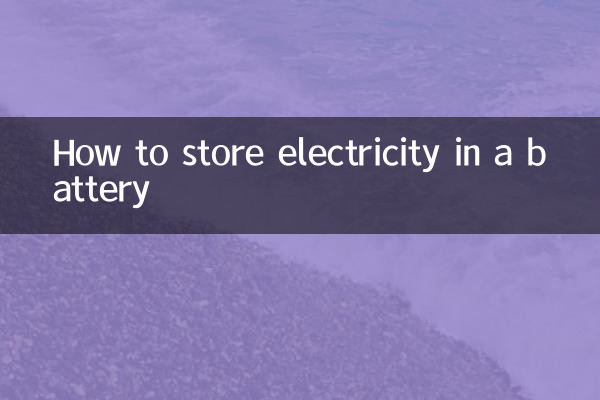How to store electricity in a battery? Revealing the principles of energy storage and popular technology trends
Among the hot topics on the entire network in the past 10 days, new energy and battery technology continue to occupy the hot search list. This article will analyze the core issue of how batteries store electricity from three dimensions: scientific principles, technical classification and market trends.
1. Basic principles of battery storage

The essence of electricity storage in all batteries is achieved through electrochemical reactions: when charged, the electrical energy is converted into chemical energy to store, and when discharged, the electrical energy is reversely converted. A recent study published by Nature Energy shows that the energy density of new batteries in 2023 is 47% higher than ten years ago.
| Battery Type | Positive electrode material | Negative electrode material | Electrolyte |
|---|---|---|---|
| Lithium-ion battery | LiCoO2 | graphite | Organic lithium salt |
| Sodium ion battery | NaFePO4 | Hard Carbon | Sodium salt solution |
| Solid state battery | Sulfide | Lithium metal | Solid electrolyte |
2. Top 5 battery technologies hotly discussed across the Internet
According to the data statistics of Baidu Index and WeChat Index in the past 7 days, the following battery technology discussion volume has grown the fastest:
| Technical name | Hot search index | Core breakthrough | Representative of the enterprise |
|---|---|---|---|
| Sodium ion battery | 8,752 | Cost reduction of 40% | CATL |
| Solid state battery | 12,463 | Energy density increase | Toyota |
| Flow battery | 5,891 | Cycling life span exceeds 25 years | Dalian Institute of Chemical Pharmaceuticals |
| Air battery | 3,245 | Very high theoretical capacity | IBM |
| Fast charging battery | 9,867 | 80% full in 15 minutes | Tesla |
3. Key factors affecting power storage efficiency
Recently, Zhihu hot posts "Why is my mobile phone battery becoming less and less durable? 》 received more than 100,000 likes, and the expert’s reply pointed out three core elements:
1.Temperature influence: Every 10℃ increase, the battery life decay rate doubles
2.Charging and discharge depth: Used in the range of 20%-80% can extend the life span by 3 times
3.Material properties: The silicon-based negative electrode has a capacity of 10 times higher than that of traditional graphite
4. Future development trends of power storage technology
According to the latest research report of Stanford University, battery technology will show the following development trends in 2024:
| Technical direction | Expected breakthrough | Commercialization time | Potential impact |
|---|---|---|---|
| Lithium metal battery | Double the energy density | 2026 | Electric vehicles have a range of over 1,000 kilometers |
| Self-healing battery | 5 times the cycle life | 2028 | Completely solve the attenuation problem |
| Biobattery | Biodegradable | 2030 | Environmental Protection Revolution |
5. The power storage issue that users are most concerned about
Weibo topic #Battery usage misunderstanding#reads exceeded 200 million, and the main questions of consumers are concentrated on:
- Does the new phone need to be filled for 12 hours?
- Does it damage the battery while charging?
- How to tell if the battery needs to be replaced?
The latest experimental data show that modern lithium-ion batteries have intelligent management systems, which are more conducive to maintaining battery health as they are used. It is recommended that users pay attention to the official battery health detection function and consider replacing it when the capacity is less than 80%.
With the advancement of the carbon neutrality goal, battery technology is ushering in explosive development. Judging from recent industry trends, 2024 may become the first year of commercialization of solid-state batteries, and sodium ion batteries are expected to be widely used in the energy storage field. Understanding these power storage principles and technical trends will help us better choose and use battery products.

check the details

check the details